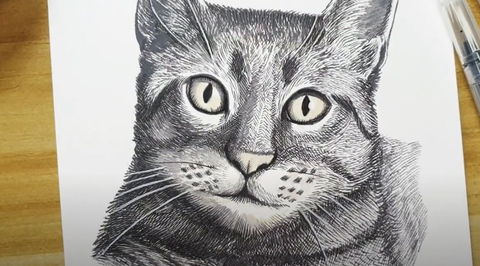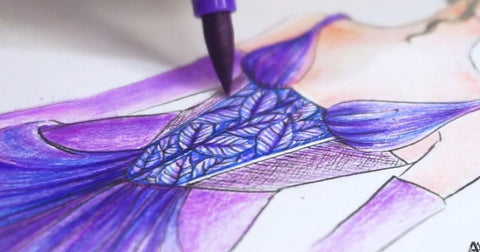Step-by-Step Tutorial for Creating Watercolor Skies
Last Updated: October 13, 2025
"Art is not what you see, but what you make others see." - Edgar Degas.
Creating beautiful watercolor skies is easier than you think! With simple steps and basic techniques, you can achieve stunning gradient backgrounds that will add a magical touch to your paintings.

Artists' Watercolor 24-Pan Set
In this tutorial, we'll guide you through the process, making it simple and enjoyable.
Materials You'll Need

- Watercolor paper or palette
- Watercolor paints
- Watercolor brushes (preferably a flat brush and a round brush) or watercolor brush markers
- Clean water
- Paper towel
- Masking tape (optional)
Choosing Your Colors

When creating a gradient background, color choice is crucial. Start with colors next to each other on the color wheel, like yellow and orange or blue and purple. These combinations blend smoothly and create a natural transition.
Wetting Your Paper
Begin by wetting your watercolor paper with clean water. This technique, known as wet-on-wet, helps the paint spread more evenly and blend smoothly. Use a flat brush to apply a generous amount of water, ensuring the paper is damp but not puddling.
Applying the First Color

Dip your brush into the first color you’ve chosen and apply it to the top of the paper. Let the paint flow down naturally. If you're painting a sky, start with a light blue at the top to mimic the atmosphere.
Blending in the Second Color
Next, rinse your brush and pick up the second color. Apply it to the bottom of the paper. You might choose a soft pink or yellow for a sky to represent the horizon. The key is to have both colors wet so they can blend seamlessly.
Creating the Gradient

To blend the two colors, gently tilt the paper from side to side. This will allow the paint to flow and mix naturally, creating a smooth gradient. You can also use a clean, damp brush to help merge the colors. Lightly brush where the two colors meet to soften the transition.
Adding Depth with Layers
Once your initial wash is dry, you can add more layers to create depth and intensity. Use a similar wet-on-wet technique to add shadows or more intense colors. This is particularly effective for creating evening skies or dramatic sunsets.
Enhancing Your Sky

To make your sky more interesting, consider adding a few clouds. While your initial gradient is still wet, use a dry brush or a paper towel to lift some of the paint. This will create soft, white cloud shapes. Alternatively, you can wait for the gradient to dry and paint clouds using white gouache.
| Tip: Clean your brushes. Rinse your brushes in warm water, gently swirl in mild soap, rinse until clear, reshape the bristles, and let dry flat or bristles down. |
Experimenting with Techniques
Don't be afraid to experiment with different techniques. You can add texture by sprinkling salt on the wet paint, which creates beautiful star-like patterns. Or, try using a sponge to dab paint onto the paper for a more textured look.

Final Touches
After your sky has dried completely, take a moment to assess your work. Sometimes, adding tiny details can bring your painting to life. Consider using a fine-tip brush to add birds, distant mountains, or stars. These small additions can make a big difference in the overall feel of your piece.
Using Reference Photos
For inspiration, use reference photos of real skies. Observing how colors transition in nature can help you create more realistic and captivating gradients. Notice how light affects the sky at different times of the day, and try to replicate those effects in your paintings.
| Tip: Experiment with painting skies at different times of the day. Morning skies might have soft pastel hues, while midday skies are bright and vibrant. Evening skies can be dramatic with deep purples and oranges. Practicing these variations will expand your skills and versatility as an artist. |
Exploring Different Paint Types
Different paints can create various effects in your gradient backgrounds. Watercolor paints come in various forms, including tubes, pans, and liquids. Tube paints are vibrant and easy to mix, while pan paints are portable and convenient.

Liquid watercolors offer intense colors and can be easily diluted for subtle washes. Experimenting with different types of watercolor paints will help you find the best tools and accessories for your style.
Create Realistic Watercolor Skies Easily with These Tips!
Creating watercolor gradient backgrounds is a delightful process that allows for endless creativity. With practice, you'll find your unique style and preferences. Remember, the key is to relax and enjoy the journey. Happy painting!
Ready to create your own watercolor skies? Explore our watercolor collection here.








